Crabs are one of the most popular crustaceans in the world. They are highly evolved arthropods with over 4300 varieties in existence.
They commonly live in the sea, but you can find them on land, in saltwater, and in freshwater. Some have even adapted to both land and water.
At the base level, there are a few standard features among crabs.
Crabs are decapods; they usually have 10 (five pairs) jointed symmetrical legs with one pair fitted with claws, also called chelae.
Some crab varieties deviate from the ten legs system, sporting eight legs like spiders.
Their bodies are segmented and are typically covered by a hard crust – exoskeleton – made up of chitin.
The exoskeleton is an essential part of the crab and saves it from predators. Some variants make their shells, while others don’t. Instead, they go looking for them.
Another common feature of crabs is antennae, which differ across the varieties.
Crabs vary widely in size. Some are as tiny as a coin, and others can easily give you a scare with how big they get.
In this article, we will expose to you common types of crabs you may see around. Let’s get into it.
Table of Contents
King Crab

The King Crab is a very common type of crab. It is enormous – easily one of the most gigantic crabs in the world. The large size, coupled with its taste, makes it a common target.
King Crab quickly measures up to 10 feet and weighs 28 pounds.
The most common subspecies of the king crab is the Red King Crab (Paralithodes camtschaticus), usually called the Alaskan King Crab.
It is usually found north of the Pacific Ocean, including the Gulf of Alaska and the Bering Sea. It is also traditionally called the Russian and Japanese crab.
Regardless of its size, most of the meat on this animal is in the legs and claws. The meat is snowy white with a red outer edge. It also has a delicate taste. Only male king crabs are harvested for food.
Blue Crab

Blue Crab is also known as the Atlantic Blue Crab. As you might expect from the name, this crab sports a blue color in its shell and legs.
This crab is a part of a swimming family of crabs. One of its pairs of legs has paddles as feet to help its swimming. Its Latin name is Callinectes sapidus, which means beautiful swimmer.
The blue crab is commonly found on the east coast of the United States. Other locations you may find these beautiful swimmers are Japan and the Gulf of Mexico. It is also reportedly found in Europe.
This type is in the medium-to-large range of crab sizes. You will find them usually 3.5 to 5 inches big, but they can grow up to 9 inches.
Furthermore, the blue crab is peculiar in the shape of its body (or carapace).
The carapace, which usually has a blue-green hue, departs from the usual round shape as it has a pointy protrusion by the side.
When cooked, the blue in this crab turns red – typical of most crabs. Their meat is tender and sweet, but it might also have a salty feel.
The blue crab can also be served soft-shelled – just after they shed the exoskeleton and the new one is yet to harden.
Dungeness Crab
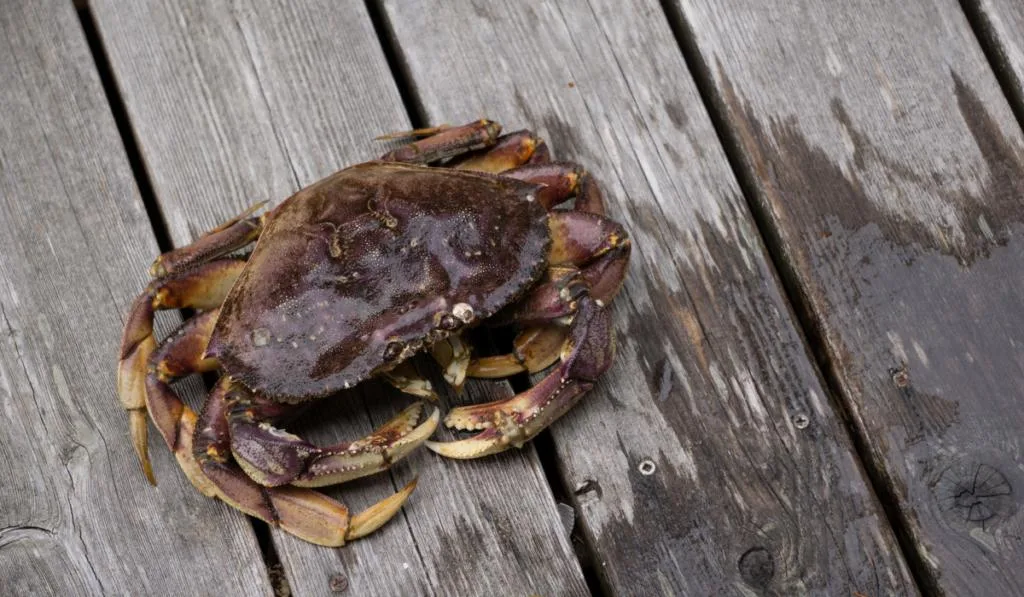
The Dungeness crab is large. Its carapace measures up to 8 inches in width. The standard weight for this crab is four pounds, or 1.8 kilograms. About a fourth of this weight is the meat you can eat.
The Dungeness crab gets its name from the town of Dungeness in Washington State. Its scientific name is Cancer magister, and it is brownish-purple in color.
This crab is reportedly one of the best crabs to eat. The meat is moist, succulent, and sweet, with a hint of saltiness.
The Dungeness crab is not harvested until it is grown to at least six and a quarter inches long.
Also, only the male crabs should be harvested as stipulated by the law.
Peekytoe Crab
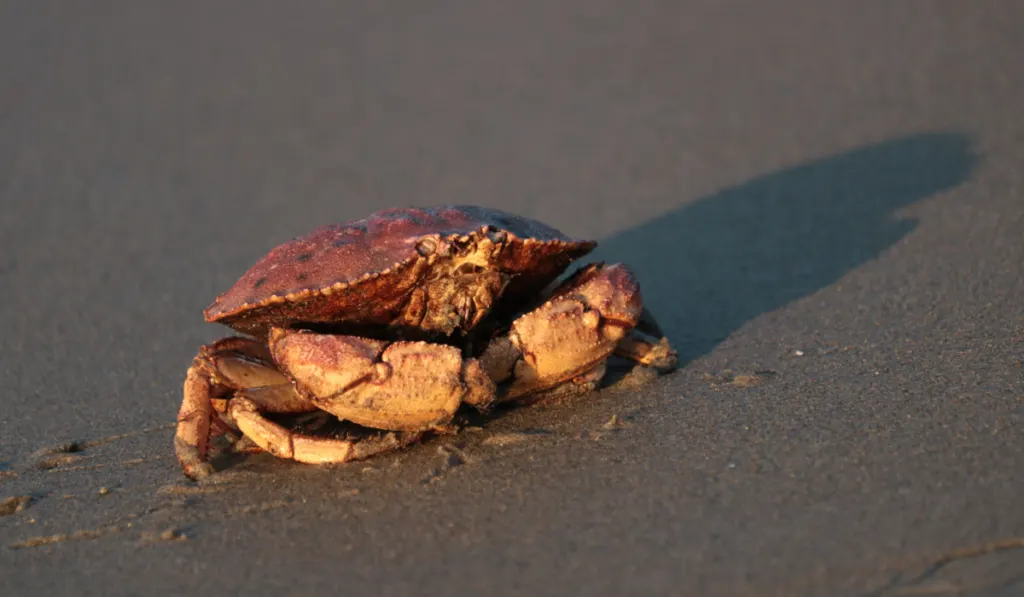
The Peekytoe crab is called many other names, including Atlantic Rock crab, Maine Rock crab, or Sand crab.
Peekytoe crabs were often overlooked in this past. They gained a lot of popularity when the name was changed to peekytoe. The name was coined in Maine, referring to the pointy legs of the crab.
It is brown with purplish spots on the shell. The peekytoe crab falls in the medium-sized category of crabs – its carapace reaches only up to 5.25 inches in diameter. It is usually found in the Atlantic Ocean.
The meat of the peekytoe crab is sweet and delicate. Since it can be used in many forms, such as crab rolls or salads, it is becoming increasingly popular.
Coconut Crab
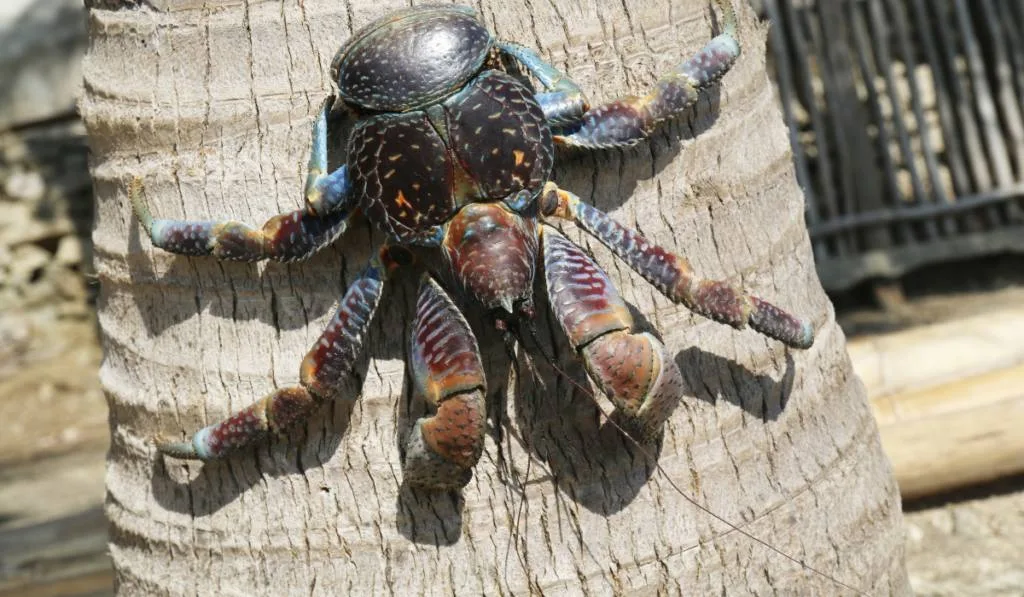
The Coconut crab is almost exclusively a land-dwelling crab. Coconut crabs are mostly found on island territories in the Pacific and Indian oceans.
It is among the largest of crabs, arguably the largest crab living on land. It can grow up to an astounding 16 inches and weigh up to 8.8 pounds.
Its scientific name is Birgus latro, and the term ‘Coconut crab’ comes up because the crab loves coconuts. It is usually found climbing up palms to feast on coconuts.
It also bagged the names ‘robber crab’ and ‘palm thief’ because it is generally on the prowl and will steal anything edible it finds.
The Coconut crab is closely related to the hermit crab. This crab is edible, and its meat is sweet and white. It is also said to be oilier than regular crab meat.
The meat of the Coconut crab, while not generally poisonous, can become so, depending on what the crab eats.
Stone Crab
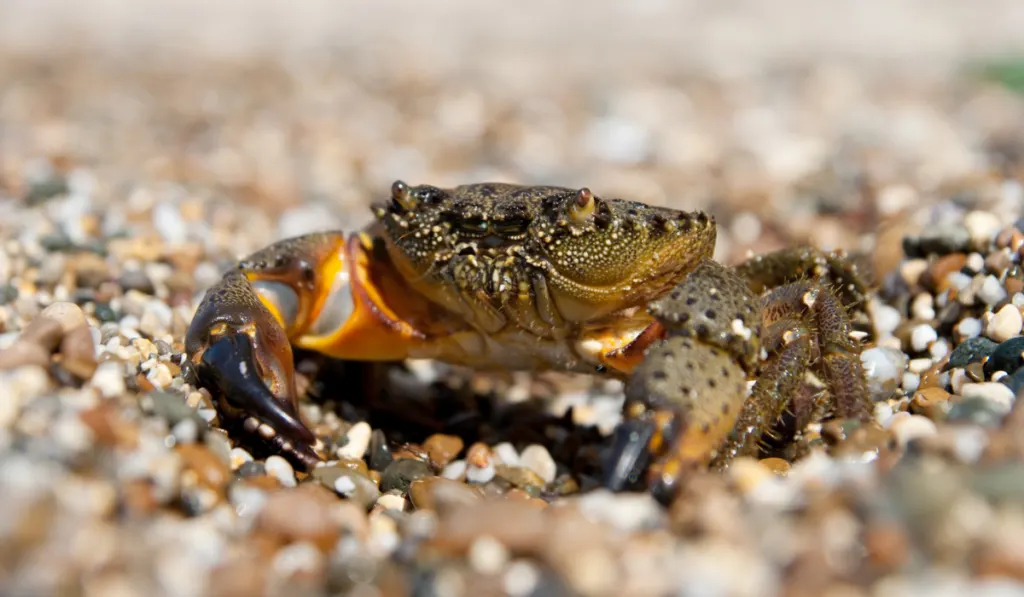
This is also known as the Florida Stone crab, and its scientific name is Menippe mercenaria.
Another name for this crab is Moro Crab. It is typically found in the western North Atlantic, and it is very common in Florida, USA.
The most prominent feature of this crab is its large pincers. The pincers are also the only part of this crab that contain meat.
The usual practice when harvesting this crab is pulling off of the claws. Since the rest of the crab will not be eaten, it is usually thrown back into the water. Within 18 months, the crab is expected to have grown a new claw.
The claws are ideally boiled for seven minutes and then frozen to remove an objectionable iodine taste in the meat. The meat from the stone crab is sweet and succulent with a firm texture.
The stone crab falls in the medium-to-large category as its carapace spans 6.5 inches.
Horseshoe Crab
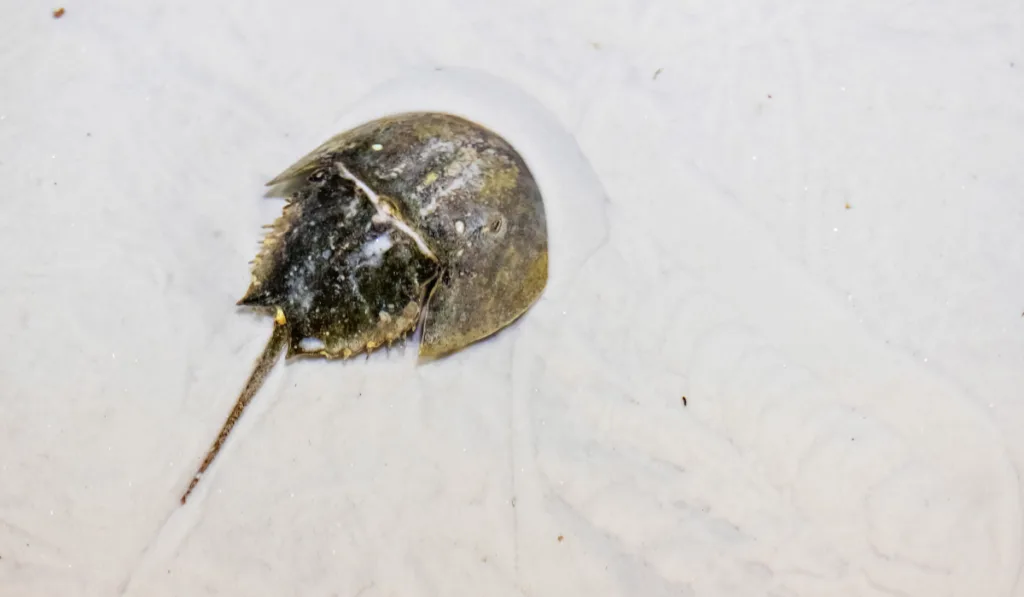
The Horseshoe crab, Limulus Polyphemus, is often not thought of as a real variety of crab. It is so named because it is shaped like a horseshoe.
Since it may have been around for as long as 500 million years, the Horseshoe crab is sometimes regarded as a living fossil.
The Horseshoe crab is found in brackish water. It commonly inhabits the shallow coastal waters of the Atlantic Ocean, and you may also find it along the Asian coasts.
Horseshoe crabs have a spiky, extended tail that many think is dangerous, even though it is not. Another of their exciting features is their ten eyes.
The horseshoe crab is edible. But it has only a little meat content, so it is rarely eaten.
Hermit Crab
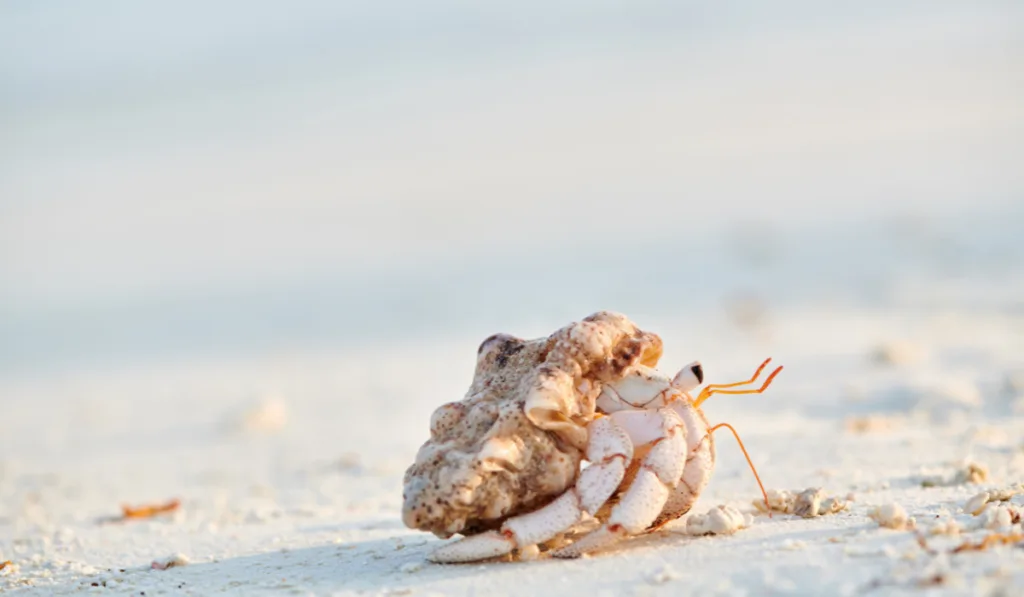
The Hermit crab is of the family Paguroidea, whose members have the characteristic of occupying empty snail shells for protection. They often have to discard any snail shell they live in as they grow.
Hermit crabs are not regarded as true crabs because they do not grow their shells, and their exoskeletons are not uniformly hard.
The shells are so crucial to Hermit crabs that they are often caught fighting over them. They sometimes kill or steal to get the shell of others.
Hermit crabs are generally small. So while they are edible, they are not usually worth the stress.
Snow Crab
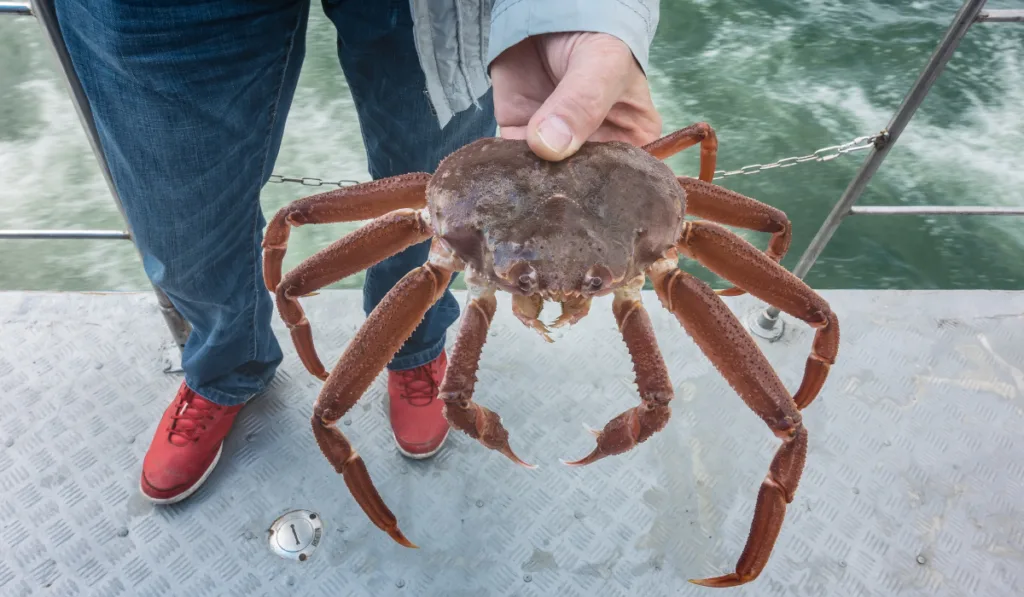
The Snow crab is a type of Alaskan crab with exceptionally long legs that make it resemble a spider. It is usually found in cold waters around Alaska as well as north of the Atlantic.
The snow crab is moderately sized and can grow as much as 7 inches from one tip of its carapace to the next. The legs and claws on this crab contain the meat, and they can be easily broken for access.
Brown Crab
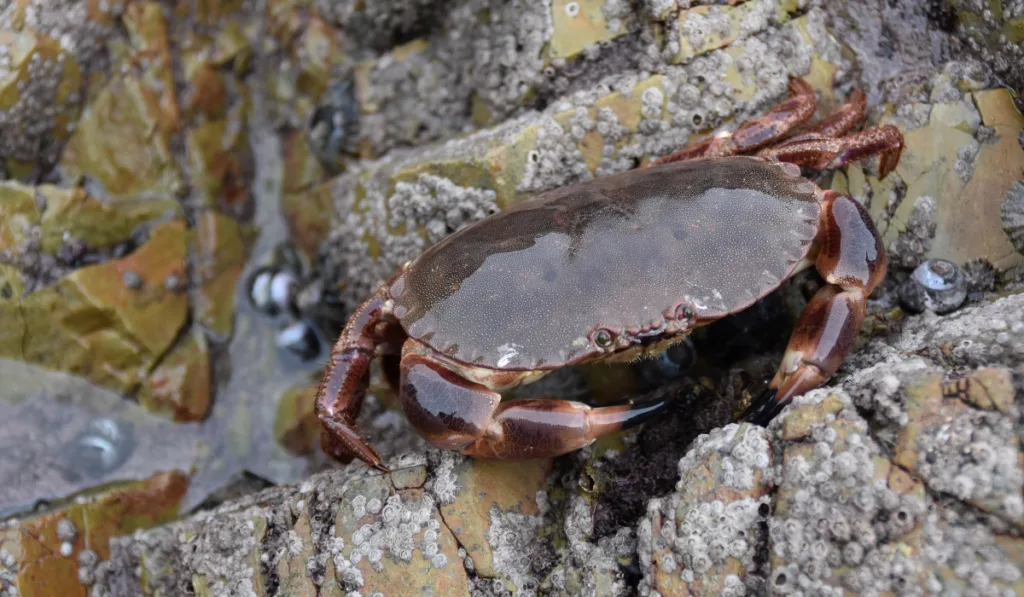
The Brown crab (Cancer pagurus) has a pie-shaped oval body. Its carapace ranges between 6 and 9 inches, putting it in the medium-sized category. In adulthood, the Brown crab can weigh up to 6.6 pounds.
It is reddish-brown, and like the stone crab, the claws have black tips. When cooked, the brown color attains a lighter shade.
The meat may be white or brown, sweet, and rich, depending on the sex of the crab.
Also known as the Edible crab, the Brown crab is quite common in the United Kingdom.
Japanese Spider Crab
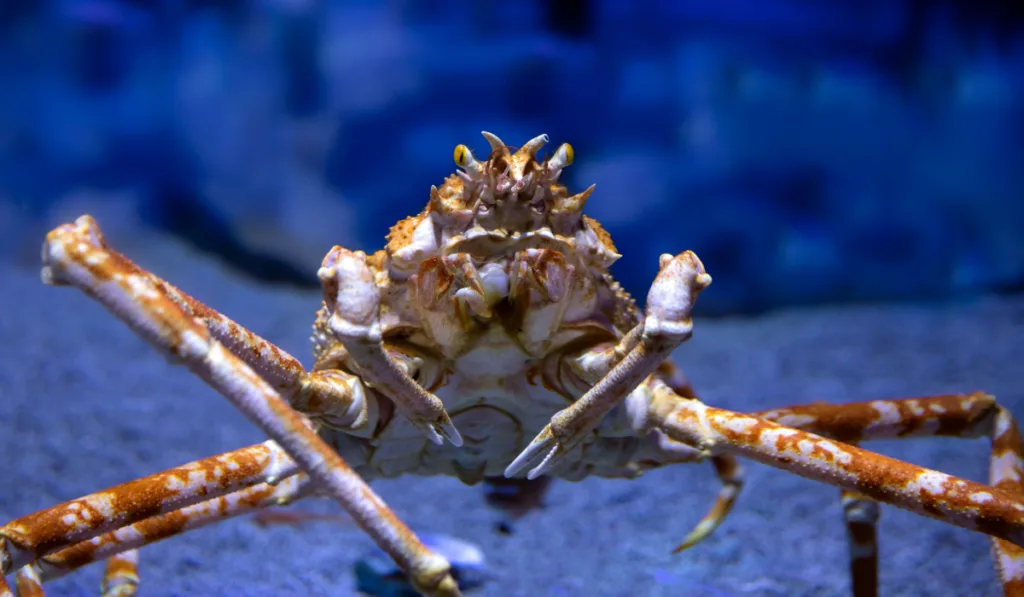
Here is another crab with legs reminiscent of a spider, as the name implies. This is one of the most gigantic crabs you may come across.
It measures up to 16 inches and weighs 42 pounds. The leg span can reach a massive length of 18 feet, and it can sometimes appear very scary.
Regardless, the Japanese Spider crab is a very delicious variety of crab. Its meat is mostly contained in those long legs.
Mosaic Reef Crab
The scientific name for this crab is Lophozizymus pictor. It is a part of the Xanthidae family, which are notorious for being poisonous.
The Mosaic Reed crab can be found in the Indian Ocean, Singapore, and other locations in coral rubble and reefs.
It has a reddish mosaic pattern with white spots on its fan-shaped body. It is small compared to other crabs on this list, spanning just around 3.2 inches.
It commonly feeds on poisonous sea cucumbers, which in turn makes its meat toxic.
Cooking does nothing to remove the toxins in the meat. So, try not eating the Mosaic Reef crab.
Emerald Crab
This is another member of the Xanthidae family. It is usually found in tropical waters, like the Caribbean Sea and the Gulf of Mexico. It is also commonly used in aquaria.
The carapace of the Emerald crab is dark-green and shiny, and it is longer than it is wide. Its large claws are spoon-shaped with white tips – different from the black tips that typify many poisonous crabs.
It is a small crab, growing up to 5 centimeters at most. Its principal food is algae and poisonous snails.
Its use in aquaria is because of its significant algae consumption. The Emerald crab is poisonous, so avoid eating it too.
The following table compares the different features of crabs.
| Crab Name | Habitat | Native location | Size | Used for food | Cost per lb. |
| King crab | Saltwater | Gulf of Alaska; North of the Pacific ocean | 11 inches | Yes | About $39 |
| Blue crab | Saltwater | Gulf of Mexico; the east coast of the US | 3.5 to 5 inches, can go up to 9 inches | Yes | $20 to $25 |
| Dungeness crab | Saltwater | West coast of North America | 8 inches | Yes | $6 to $9 |
| Peekytoe crab | Saltwater | Atlantic ocean | 5.25 inches | Yes | $40 to $45 |
| Coconut crab | Land | Islands on the Pacific and Indian oceans | Up to 16 inches | No | $5 to $18 |
| Stone crab | Saltwater | Florida; western North Atlantic | 6.5 inches | Yes | About $30 |
| Horseshoe crab | Brackish water | Coastal water of the Atlantic ocean | Up to 2 feet (24 inches) | No | – |
| Hermit crab | Both | Indo-Pacific, western Atlantic, and Caribbean regions | 0.5 to 4 inches | No | $3 to $20 |
| Snow crab | Saltwater | Northwest of the Atlantic and north of the Pacific | 7 inches | Yes | About $20 to $23 |
| Brown crab | Saltwater | North sea, north of the Atlantic | 6 to 9 inches | Yes | About $10 |
| Japanese Spider crab | Saltwater | Japan | Up to 16 inches | Yes | More than $100 |
| Mosaic reef crab | Coral rubble and reefs | Asia: Japan, Singapore; Indian ocean | 8 centimeters | No | – |
| Emerald crab | Saltwater | Atlantic ocean, Caribbean, Gulf of Mexico | 5 centimeters | No | – |
Resources
- https://leafyplace.com/types-of-crabs/
- https://www.thespruceeats.com/crab-varieties-and-types-1808801#dungeness-crab
- https://nayturr.com/types-of-crabs/
- https://www.animalwised.com/different-crab-types-with-names-and-pictures-3203.html
- https://naturetingz.com/types-of-crabs/
- http://ourmarinespecies.com/c-crabs/poisonous-crabs/
- https://teara.govt.nz/en/crabs-crayfish-and-other-crustaceans/page-1
- https://animals.mom.com/distinguishing-characteristics-crabs-9224.html
- https://www.nparks.gov.sg/florafaunaweb/fauna/0/9/09
- https://www.alibaba.com/showroom/coconut-crab.html
- https://hermitcrabowner.com/how-much-does-it-cost-to-purchase-raise-hermit-crabs
